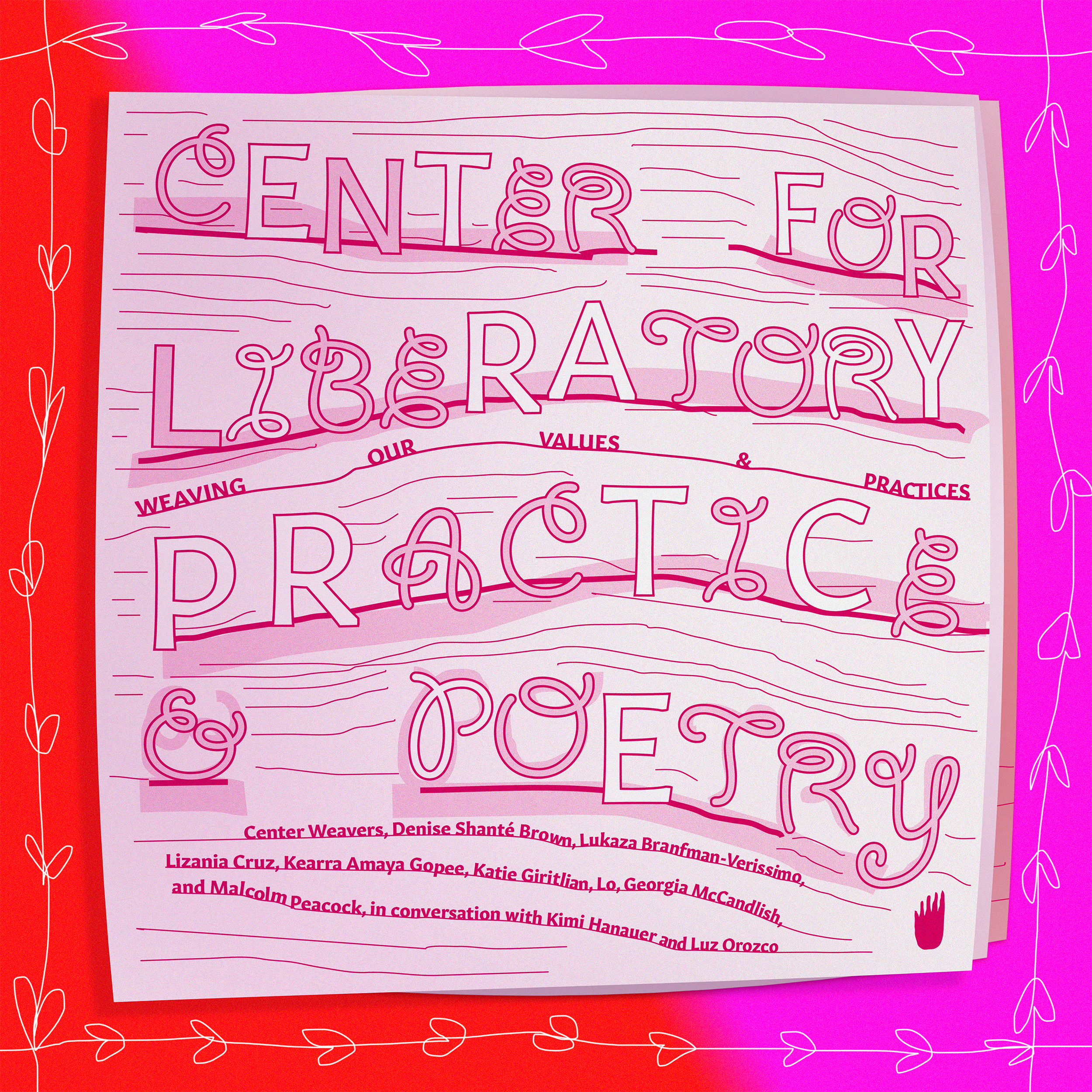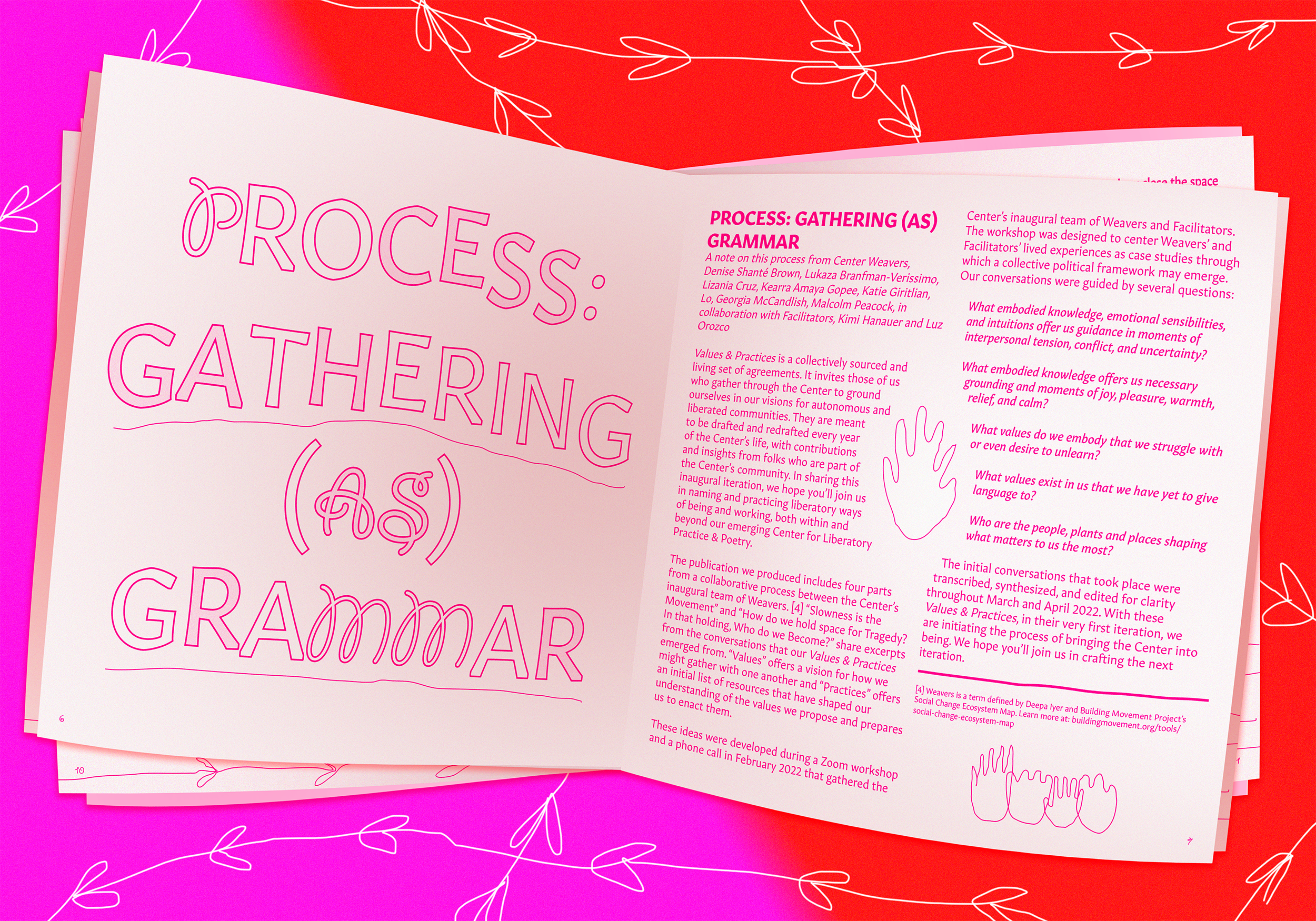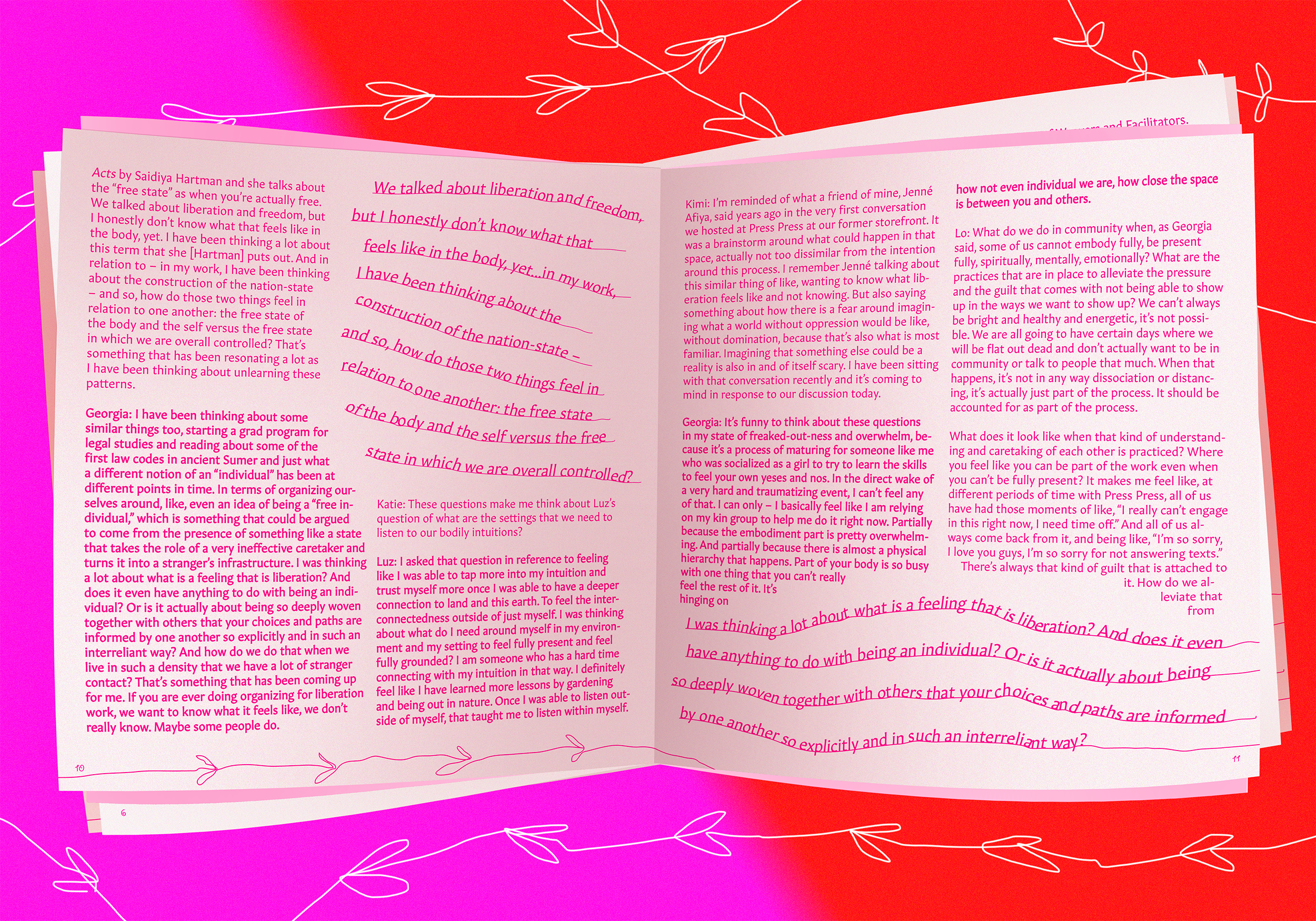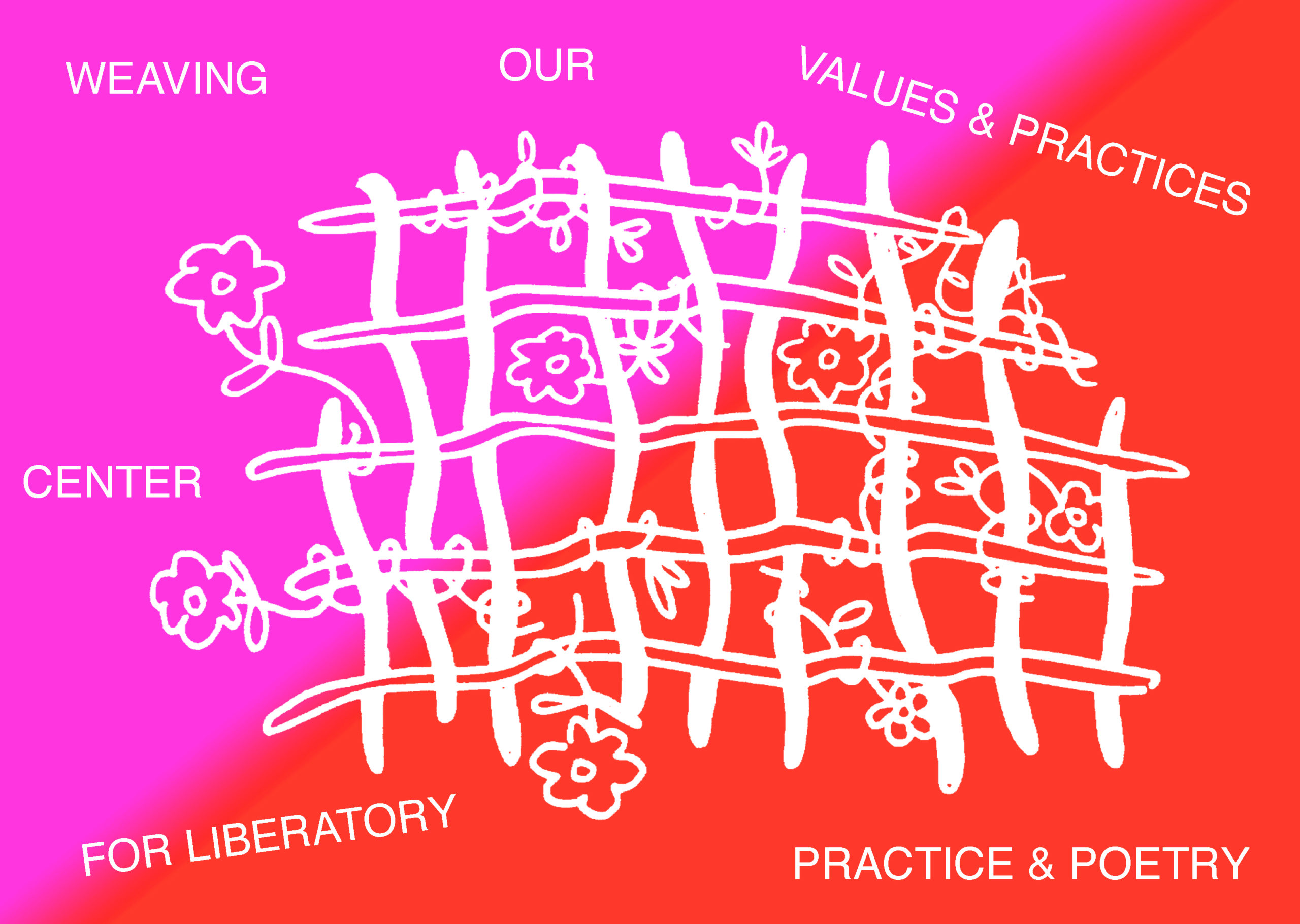Weaving Our Values & Practices
Center for Liberatory Practice & Poetry
September 2022
ONE OF MANY CENTERS
A note from Kimi Hanauer, Center Steward
The Center for Liberatory Practice & Poetry is a nomadic and virtually-based education center that gathers a community of learners around ways of being, sensing, and making that enact liberation in everyday life. The Center is an attempt at building a nimble, reflexive, and fluid organizational structure: one that has emerged from and continues to be transformed by its relationships. It’s conceived of as an organism that is born, lives, and will eventually die. The slow process of initiating this project began in 2020 as a way of honoring the fruits and dreams that have emerged through the personal and collective cultural work I have engaged in alongside many friends, family, and community members1 and, specifically, several collectively authored projects I was involved with during the first two years of the ongoing pandemic. These include Toolkit for Cooperative, Collective, and Collaborative Cultural Work co-published by Press Press and Institute for Expanded Research; Poetry for Persistence co-organized by Press Press and Printed Matter; and bless our breath, which I organized in collaboration with Gas. These projects gathered practitioners across Turtle Island who shared essential insights, practices, conversations, artworks, and poetry that became a foundation for this Center-in-process to grow.
In the essay “Theory as Liberatory Practice,” bell hooks speaks to the function of theory as a medium that can intentionally be made liberatory, healing, and revolutionary.2 hooks’s work on the liberatory potential of education has been integral to the initiation of the Center. In the spirit of her teachings, the Center emphasizes the seemingly mundane interactions of our everyday lives as sacred openings for liberatory practice. It’s an invitation to explore liberatory practices in each of our worlds; to trace and unsettle the bodily, social, spiritual, and political borders that have produced sites of dispossession; and, ultimately, to deepen our landscapes of belonging.3
The Center is a way of holding space for the perpetually unfinished and unresolved work of liberatory practice and poetry, while intentionally leaving that work open to many others to be remade, reinterpreted, and decentralized across various contexts. This aim requires that we, those who constitute the Center, move beyond presumed boundaries of individual and collective authorship, and instead ask: What are the anchors of autonomous and liberated communities? What do genuine relations of solidarity require? How do we practice life-sustaining mutual aid and poetry in everyday life?
While there is much to learn and share, stewardship of the Center thus far has been guided by the understanding that our commitment to recognizing the inherent value in ourselves and others as living beings of our pasts, presents, and futures offers us one initial ground. I hope you’ll join us in asking: How do liberatory practices take shape in your life?

PROCESS: GATHERING (AS) GRAMMAR
A note on this process from Center Weavers Denise Shanté Brown, Lukaza Branfman-Verissimo, Lizania Cruz, Kearra Amaya Gopee, Katie Giritlian, Lo, Georgia McCandlish, Malcolm Peacock, in collaboration with workshop facilitators, Kimi Hanauer and Luz Orozco
Values & Practices is a collectively sourced and living set of agreements. It invites those of us who gather through the Center to ground ourselves in our visions for autonomous and liberated communities. The agreements are meant to be drafted and redrafted every year of the Center’s life, with contributions and insights from folks who are part of the Center’s community. In sharing this inaugural iteration, we hope you’ll join us in naming and practicing liberatory ways of being and working, both within and beyond our emerging Center for Liberatory Practice & Poetry.
The full publication we produced includes four parts from a collaborative process between the Center’s inaugural team of Weavers.4 “Slowness is the Movement” and “How Do We Hold Space for Tragedy? In That Holding, Who Do We Become?” share excerpts of the conversations from which our Values & Practices (included below) emerged. “Values” offers a vision for how we might gather with one another and “Practices” offers an initial list of resources that have shaped our understanding of the values we propose and prepares us to enact them.
These ideas were developed during a Zoom workshop and a phone call in February 2022 that gathered the Center’s inaugural team of Weavers and Facilitators. The workshop was designed to center Weavers’ and Facilitators’ lived experiences as case studies through which a collective political framework may emerge. Our conversations were guided by several questions:
What embodied knowledge, emotional sensibilities, and intuitions offer us guidance in moments of interpersonal tension, conflict, and uncertainty?
What embodied knowledge, emotional sensibilities, and intuitions offers us necessary grounding and moments of joy, pleasure, warmth, relief, and calm?
What values do we embody that we struggle with or even desire to unlearn?
What values exist in us that we have yet to give language to?
Who are the people, plants, and places shaping what matters to us the most?
The initial conversations that took place were transcribed, synthesized, and edited for clarity throughout the Spring and Summer of 2022 (available in the full PDF). With these values and practices, we are initiating the process of bringing the Center into being. We hope you’ll join us in crafting the next iteration.

VALUES & PRACTICES
The following Values & Practices, gathered through our conversations (available in the full PDF), are offerings that emerge from our day-to-day lives, embodied knowledges, and the histories we carry. They are meant to ground the Center’s work within a reflexive collectively-sourced vision.
VALUES Offer a Vision for How We Might Gather with One Another
At the Center for Liberatory Practice & Poetry we strive to embody . . .
SPEAKING INTO BEING
How do we speak our visionary worlds into being? Naming our experiences, especially when the words do not yet exist, can be a powerful act of world-building.
FLEXIBILITY FOR HOLDING
How can we instill flexibility for holding? Holding different capacities and language for labor, unlearning, and imagination, within our own shifting selves as well as for those with whom we’re practicing these values.
PAUSE, SILENCE, LISTENING, AND SLOWNESS
How do we honor pause, silence, listening, and slowness? Observing our own silences can allow others to be listened to.
CONNECTIONS TO MULTIPLE HOMES AND LANDS
How do we name and nourish our connections to multiple homes and lands – both physical, imagined, and interpersonal – and the ways we are interwoven with one another?
FEELINGS AS INFORMATION
How do we center our feelings as information that can shape our futures? We don’t know what liberation really feels like in our bodies, but we have felt a glimpse of it in our dreams. That in and of itself is a space to dwell in.
SPACIOUSNESS AND DWELLING
How do we create openings for spaciousness and dwelling inside ourselves and within our relationships? What space might this dwelling be supporting that has otherwise been pushed out?
QUESTIONS AND CURIOSITY
How do we open space for more questions and curiosity while being okay with not having the answers to our questions?
DETOX AND GRACIOUSNESS
How do we hold space for a genuine detox that we all need from the structures of domination we live under? How do we offer graciousness for ourselves and others when we fuck up? It’s important to recognize when we might come from a place of hurt or past experience of violence and that conflict is inevitable.
RECOGNIZING AND PARSING OUT OUR HURT
How can we recognize and parse out our hurt, so we don’t recreate dynamics of oppression in the new spaces we are building? We might not know what liberation feels like in our bodies, but we do know what oppression feels like. How do we not internalize the trauma that we have experienced?
PRACTICE FOR THE LONG GAME
How can we practice resisting domination and rehearsing the worlds we want to inhabit in everyday life? When we have small conflicts with friends or in community and we address them with direct, nonviolent communication and seek to resolve them truly, we are practicing for when the bigger things come up. The mundanity of life can be practice for the long game; moving the muck out of the way and bringing down our threshold for what’s scary to do.
CHECKING IN WITH OURSELVES AS WE CHANGE AND GROW
How can we be open to trusting our own ability to grow and assess new needs for ourselves? Through relationships and being in community, we understand our needs in ways we didn’t anticipate before. How do we check in with ourselves and communicate those needs so that our relationships can feel fulfilling? Not in a capitalist kind of way, but in a “I’m happy to be alive” kind of way.
SENSING AS A SACRED ACT
How do we know and feel the inherent sacredness in ourselves and all that we touch and sense? Sensing in any kind of way is a sacred act. How can we hold that reminder for ourselves in everyday life, and especially when we are encountering challenges?
WE ARE THE BAROMETER FOR WHAT IS NECESSARY
How do we offer ourselves the intimate space to check in before catastrophe occurs? If we learn to trust and listen to our bodies, we can be the barometer and the sensor for what is necessary for us.
TRUST AS A LIBERATOR OF INTIMATE SPACE
How do we develop measures for knowing what trust feels like for each of us personally, on an individual level? Trust is individual. Trust has to deal with traumas. Trust is the foundation for genuine collectivity. If you have trust, you can address conflict without shame, without fear of being dismissed.

PRACTICES Offer Resources, Tools, and Strategies That Might Equip Us to Enact the Values We Propose
This is an evolving list of resources that have informed our work and will be updated as time goes on.
Prompts for attuning to collective dynamics, such as asking, “What does the space need?” can be used as a score for prompting artistic improvisation (such as in movement, play, and imagination-building), as well as for facilitating conversation.5
- “Cultivating the Self: Embodied Transformation for Artists” by Alta Starr6
- “Venus in Two Acts” by Saidiya Hartman7
- The Making Of: Publics & Liberation by Press Press, featuring Jenné Afiya, Fire Angelou, Emeline Boehringer, Kory Sanders, Kimi Hanauer, Sarrita Hunn, and Malcolm Peacock8
- Uses of the Erotic: The Erotic as Power by Audre Lorde9
- Care Manual: Dreaming Care into Being by kamra sadia hakim10
- Mapping Our Roles in Social Change Ecosystems by Deepa Iyer, Building Movement Project11
- “Unlearning: From Degrowth to Decolonization” by Jamie Tyberg12
- Undoing Borders: A Queer Manifesto by SF Chapter of Pride At Work / Horizontal Alliance of Very (or Vaguely or Voraciously) Organized Queers (HAVOQ)13
- “The Short Instructional Manifesto for Relationship Anarchy” by Andie Nordgren14
- “Access Intimacy: The Missing Link” by Mia Mingus15
- “Anti-Oppression Facilitation for Democratic Process: Making Meetings Awesome for Everyone” by Anti-Oppression Resource and Training Alliance (AORTA)16
- “Accessibility in the Arts: A Promise and a Practice” by Carolyn Lazard17
- “10 Principles of Disability Justice” by Sins Invalid18
- How to Build Language Justice by Antena19
- Braiding Sweetgrass: Indigenous Wisdom, Scientific Knowledge, and the Teachings of Plants by Robin Wall Kimmerer20
- Citizen: An American Lyric by Claudia Rankine21
We hope this list will continue as our work comes into being.
SHAPING OUR GROUNDS
While holding these in-process values and practices in mind, we will continue to cultivate the materiality of our work: What shape(s) will our Center take? How do these values and practices take concrete form in our lives and work? What is the ground we are collectively building? What do our values call on us to do? These are some of the questions that come to mind as we reflect on our conversations thus far. Thank you for moving with us as we begin to form our work into action.
Footnotes
- Specifically, the deep relationships I have been lucky to foster through Press Press, an interdisciplinary publishing initiative I co-organize with Bilphena Yahwon, Lo, Vale Cabezas, as well as many others who flow in and out of the work.
- bell hooks, “Theory as Liberatory Practice,” in Teaching to Transgress: Education as the Practice of Freedom (London: Routledge, 1994), 59–75.
- While widely used, I first heard the term “landscapes of belonging” used in the context of Ella Shohat’s teachings. For example, she narrates her own relationship to “home” and “belonging” in the interview, “Forget Baghdad: Arabs and Jews, the Iraqi Connection” with Naeim Giladi and Ella Shohat that took place as part of the 2012 Anywhere But Now: Landscapes of Belonging in the Eastern Mediterranean conference and publication.
- “Weavers” is a term defined by Deepa Iyer and Building Movement Project’s Social Change Ecosystem Map.
- This question was carried by Katie Giritlian from an improvisatory movement workshop led by Jade Manns and Owen Prum with Improv Club at Prospect Park in fall 2021.
- Alta Starr, “Cultivating the Self: Embodied Transformation for Artists,” in Making & Being: Embodiment, Collaboration, and Circulation in the Visual Arts, a Workbook, ed. Susan E. Jahoda and Caroline Woolard (Brooklyn: Pioneer Works Press, 2019), 47–63.
- Saidiya Hartman, “Venus in Two Acts,” Small Axe: A Caribbean Journal of Criticism 12, no. 2 (2008): 1–14, https://doi.org/10.1215/-12-2-1.
- Jenné Afiya, Fire Angelou, Emeline Boehringer, Kory Sanders, Sarrita Hunn, and Malcolm Peacock, The Makings Of: Publics & Liberation, ed. Kimi Hanauer (Baltimore: Press Press, 2017).
- Audre Lorde, Uses of the Erotic: The Erotic as Power (Tucson: Kore Press, 2000).
- kamra sadia hakim, Care Manual: Dreaming Care into Being (Detroit: Flower Press, 2022).
- Deepa Iyer, “Mapping Our Roles in Social Change Ecosystem,” Deepa Iyer, Building Movement Project, 2018, http://deepaiyer.com/the-map-social-change-ecosystem/.
- Jamie Tyberg, “Unlearning: From Degrowth to Decolonization,” Rosa Luxemburg Stiftung, July 3, 2020, https://rosalux.nyc/degrowth-to-decolonization/.
- Undoing Borders: A Queer Manifesto, SF Chapter of Pride At Work / the Horizontal Alliance of Very (or Vaguely or Voraciously) Organized Queers (HAVOQ), April 2011.
- Andie Nordgren, “The Short Instructional Manifesto for Relationship Anarchy,” The Anarchist Library, July 14, 2012.
- Mia Mingus, “Access Intimacy: The Missing Link,” Leaving Evidence (blog), August 15, 2017.
- Anti-Oppression Resource and Training Alliance (AORTA), “Anti-Oppression Facilitation for Democratic Process: Making Meetings Awesome for Everyone,” June 2017.
- Carolyn Lazard, “Accessibility in the Arts: A Promise and a Practice,” Recess Art, 2019, https://promiseandpractice.art.
- “10 Principles of Disability Justice,” Sins Invalid, September 17, 2015.
- Antena, How to Build Language Justice = cómo Construir La Justicia Del Lenguaje (Houston: Antena Books / Libros Antena, 2013).
- Robin Wall Kimmerer, Braiding Sweetgrass: Indigenous Wisdom, Scientific Knowledge and the Teachings of Plants (London: Penguin Books, 2020).
- Claudia Rankine, Citizen: An American Lyric (London: Penguin Books, 2015).
Center For Liberatory Practice & Poetry aims to gather a community of learners around ways of being, sensing, and making that enact liberation in everyday life.
